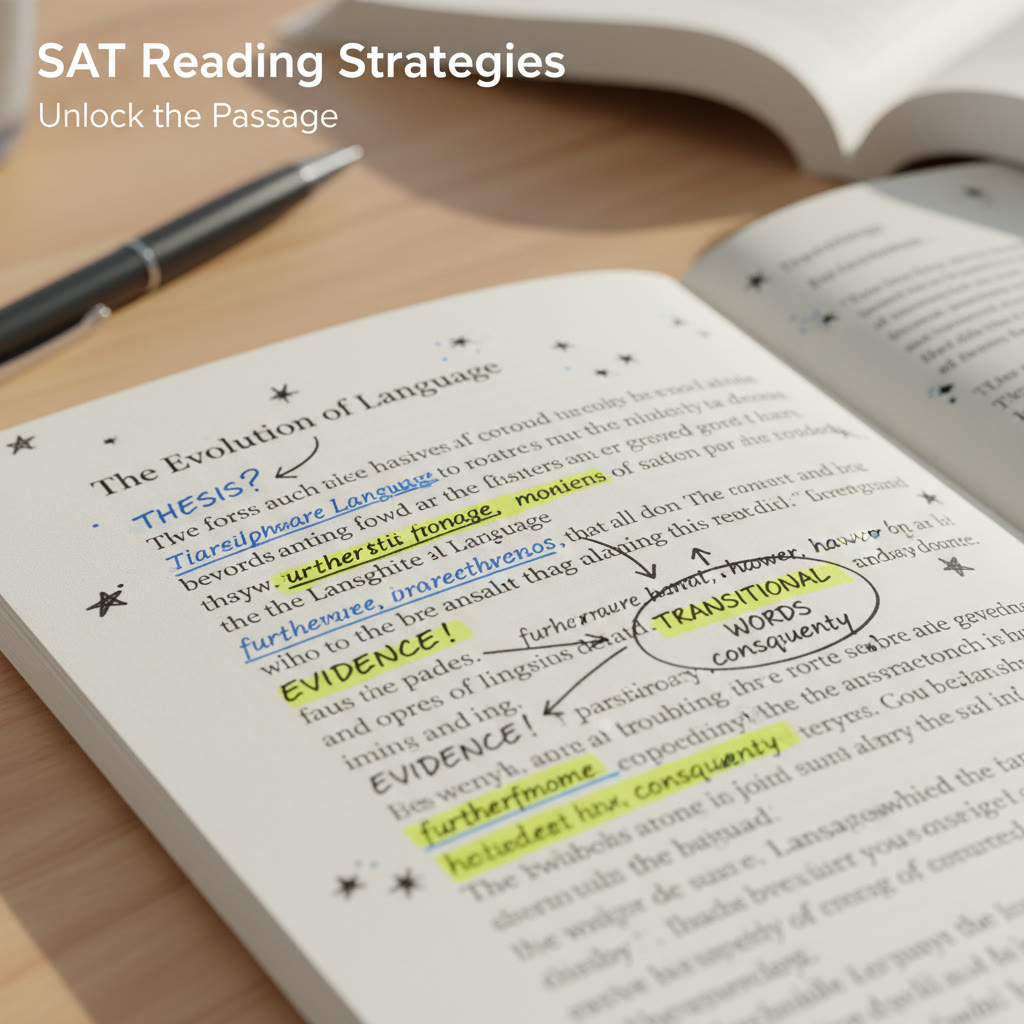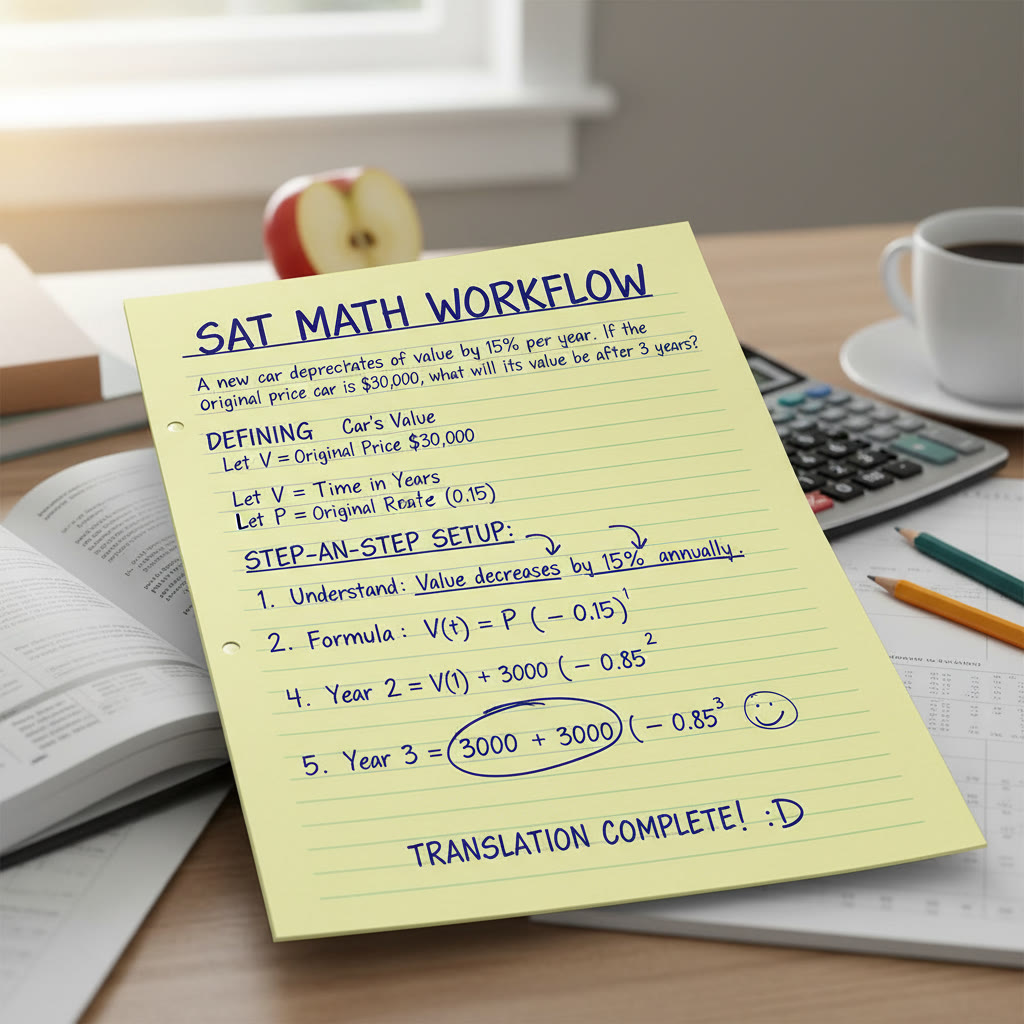Introduction: Why logical reasoning matters on the SAT
If you ask high scorers what helped them most on the SAT, many will say the same thing: it wasn’t memorizing obscure grammar rules or cramming every math formula. It was learning how to think clearly under pressure. The SAT is less about trivia and more about reasoning — evaluating evidence, spotting assumptions, drawing valid inferences, and following chains of thought to a sound conclusion.
That emphasis shows up in every section. Logical reasoning is woven into Evidence-Based Reading, Writing & Language, and Math. In this blog we’ll map where and how logical reasoning appears, break down concrete strategies you can use, examine sample questions step-by-step, and offer a study roadmap so you can practice deliberately. Along the way, you’ll see how targeted help — like Sparkl’s personalized tutoring with 1-on-1 guidance, tailored study plans, expert tutors, and AI-driven insights — can accelerate progress when you want to sharpen specific reasoning skills.
Where logical reasoning appears on the SAT
Logical reasoning shows up in three main places on the SAT:
- Evidence-Based Reading: interpreting passages, making inferences, and understanding arguments.
- Writing & Language: choosing the best way to present evidence, improve clarity, and fix faulty logic in sentences and paragraphs.
- Math: solving multi-step problems, setting up equations from words, and interpreting data and functions.
Evidence-Based Reading: logic of passages and arguments
Reading questions ask you to read like an analyst. They don’t just test your vocabulary or recollection of facts. They test whether you can:
- Identify the author’s main claim and purpose.
- Distinguish between what the passage states explicitly and what follows implicitly.
- Evaluate how evidence supports a conclusion and whether a counterargument is addressed.
- Track a line of reasoning across sentences and paragraphs.
Typical question types include central idea, function of a paragraph, inference, supporting evidence, and interpretation of data or experiments quoted in the passage.
Writing & Language: logical clarity and structure
On Writing & Language, the test focuses on clarity, concision, and whether sentences and paragraphs present information logically. Expect questions like:
- Which sentence best supports the previous claim?
- Which revision improves the organization of ideas?
- Where is a transition needed to make the argument flow?
These items are practical logic tests: they ask you to judge cause and effect, chronology, emphasis, and the best way to lead the reader from idea A to idea B.
Math: reasoning with numbers, formulas, and real-world context
SAT Math rewards careful setup and logical sequencing. Many problems are word problems that require translating a story into algebra, deciding how to model a situation, or interpreting graphs and tables. Logical skills include:
- Defining variables clearly and consistently.
- Working step-by-step and checking whether intermediate steps are reasonable.
- Choosing the simplest valid method rather than doing the most complicated algebra.
Common logical traps and how the SAT uses them
The SAT writers design questions to probe reasoning, not to trick you with impossible math. Still, there are common traps that test the subtlety of your logic skills:
- Confusing correlation with causation — a frequent issue in passages that present data.
- Overgeneralization — drawing a strong conclusion from a narrow piece of evidence.
- Ignoring exceptions or caveats mentioned in the passage.
- Mixing up conditional language: if, only if, unless, and other logical connectors.
Recognizing these traps helps you pick answers that reflect careful thinking rather than quick intuition.
Example trap: conditional statements
Conditional language is everywhere on the SAT. A sentence like, ‘If students study for two hours each day, then their scores improve,’ does not imply that studying two hours is the only way to improve scores, or that those who didn’t study two hours won’t improve. The SAT expects you to pay attention to that difference. Answers that overstate or misinterpret conditionals are usually wrong.
Practical strategies: how to think when a question demands logic
These techniques are portable across sections. Train them intentionally with practice questions.
- Restate the claim in plain English. Replace dense academic phrasing with a one-sentence summary. That makes hidden assumptions easier to spot.
- Ask the evidence question. For argument questions, always ask: what evidence supports this claim? Is it direct, indirect, or absent?
- Work backward for wrong answers. If several choices look plausible, eliminate those that introduce new assumptions or go farther than the passage allows.
- Use the process of elimination early. On Writing & Language, remove options that create ambiguity or break parallelism. On Math, eliminate answers that violate units or produce impossible quantities.
- Check extremes and opposites. Many wrong choices are extreme restatements or reversals of the passage’s position.
Active reading habits that reveal structure
When reading a passage, do these quick moves:
- Note the thesis sentence — often in the introduction or conclusion.
- Mark transitions that signal contrast, cause, or emphasis: however, therefore, consequently, but, yet.
- Underline examples or data the author uses as evidence; ask whether those examples actually prove the claim.
Step-by-step walkthroughs: sample questions and solutions
Seeing logical reasoning in action helps you apply it. Below are concise examples from Reading, Writing & Language, and Math that show how to think through a problem.
Reading example: inference and evidence
Passage excerpt (shortened and original): A biologist observes that two populations of the same species of beetle show different wing patterns after being geographically separated for several generations. The biologist suggests that environmental factors, such as temperature and predators, contributed to this divergence.
Question: Based on the passage, which conclusion can be drawn?
- A. The beetles’ wing patterns evolved solely because of genetic mutations.
- B. Environmental factors likely played a role in the differences in wing patterns.
- C. The beetles will reconverge if the environments become similar.
- D. Predators are the only cause of the wing differences.
Think it through: the passage says the biologist suggests environmental factors contributed. That supports B. Choices A and D are too strong — they say solely or only. Choice C assumes future change without evidence. The correct answer is B because it matches the strength and scope of the passage’s claim.
Writing & Language example: improving logical flow
Sentence pair in context: ‘The study found a correlation between sleep and test performance. Therefore, students should sleep more to secure higher scores.’
Question: Which revision best corrects a logical error in the passage?
- A. No change.
- B. ‘The study found a correlation between sleep and test performance; thus, students who sleep more tend to perform better.’
- C. ‘The study proved that more sleep causes higher test scores.’
- D. ‘Students should sleep more, and this will guarantee higher scores.’
Analysis: The original jumps from correlation to causation. Choice C makes the same mistake with even stronger language. Choice D promises a guarantee. Choice B accurately restates the finding without claiming causation. So B is the best fix because it keeps the logical relationship accurate and measured.
Math example: translating words into equations
Question: A rectangle’s length is 3 more than twice its width. If the area is 77 square units, what are the rectangle’s dimensions?
Step 1: Define variables: let w be width, L be length. The problem gives L = 2w + 3 and area A = L * w = 77.
Step 2: Substitute: w(2w + 3) = 77, so 2w^2 + 3w – 77 = 0.
Step 3: Solve the quadratic: use the quadratic formula or factor. Factors of 2* -77 = -154 that sum to 3 are 14 and -11, so 2w^2 + 14w – 11w – 77 = 0. Grouping gives 2w(w+7) -11(w+7) = (w+7)(2w-11) = 0. So w = 11/2 = 5.5 or w = -7 (reject negative).
Step 4: Find length: L = 2(5.5) + 3 = 11 + 3 = 14. So the rectangle is 5.5 by 14. Double-check by computing area 5.5 * 14 = 77. Logical structure and careful variable definition made this straightforward.
Study plan: practice that builds reasoning, not just speed
The goal is to make logical thinking automatic, so it survives stress and time pressure. Here’s a six-week focused plan you can adapt:
- Week 1: Diagnostic. Take a full practice section (Reading or Math). Identify recurring mistakes that are logic-based: mistaken inferences, misread conditionals, unsupported assumptions.
- Week 2: Fundamentals. Practice making inferences from short texts and solving word problems. Keep a mistake log focusing on the type of logical error.
- Week 3: Targeted drills. Do sets of 10 questions on inference, main idea, and evidence. For Math, focus on setup and translation from words.
- Week 4: Mixed practice and timing. Practice mixed sections under timed conditions, but pause to analyze tricky logic questions slowly afterward.
- Week 5: Weakness attack. Use your log to target your two biggest logical weaknesses. Consider 1-on-1 tutoring sessions to get tailored feedback and strategies.
- Week 6: Test readiness. Simulate testing conditions twice, review every missed question with emphasis on the reasoning error, and relax the day before the test.
If you want personalized guidance, a program like Sparkl’s personalized tutoring can help at the weakness-attack stage: expert tutors can design tailored study plans, give 1-on-1 guidance on specific logical patterns you struggle with, and use AI-driven insights to track progress efficiently.
Measuring progress: metrics that matter
Instead of obsessing over overall score every day, track metrics that reflect reasoning growth:
- Accuracy on inference/evidence questions in Reading — track separately from detail questions.
- Rate of avoiding extreme or unsupported answer choices.
- For Math, percentage of word problems correctly translated and solved on the first attempt without rework.
- Time spent reasoning per question: aim to reduce this for easier logic items while maintaining accuracy.
Sample progress table
| Metric | Week 1 | Week 4 | Week 6 |
|---|---|---|---|
| Reading: Inference accuracy | 60% | 75% | 85% |
| Writing: Function/question accuracy | 65% | 80% | 88% |
| Math: Word-problem correct setup | 55% | 70% | 83% |
These are example numbers, but they illustrate what progress can look like: logical accuracy often increases steadily if practice is deliberate and feedback is specific.
Practice activities that build reasoning muscle
Here are focused drills that you can do in short bursts every day:
- Daily one-paragraph inference: read a short op-ed or science blurb and write the author’s claim and two pieces of evidence. Then note any assumptions.
- Conditionals workout: find 10 sentences in practice tests with words like if, only if, unless, or whenever and rewrite them to clarify the logical structure.
- Math set-up drill: convert 12 word problems into equations without solving them. Check if your equations reflect the text.
- Error log review: after each practice session, categorize each wrong answer by the kind of logical mistake, not just content type.
How tutoring can speed the logic-learning curve
Studying alone is fine for many tasks, but targeted feedback shortens the path to durable improvements. A tutor can:
- Spot recurring reasoning errors you might not notice, like a habit of picking emotionally appealing answers.
- Provide immediate counterexamples to shaky inferences so you learn to test claims rather than accept them.
- Design practice that mimics the exact logical patterns you struggle with.
For students who prefer a customized approach, Sparkl’s personalized tutoring offers 1-on-1 guidance with expert tutors, tailored study plans, and AI-driven insights that highlight which logical skills to practice next. That combination can be especially useful when you’ve plateaued and need a second opinion on how you reason through tricky items.
Final tips: staying calm and thinking clearly on test day
On test day, your best asset is clear thinking. A few practical habits help:
- Read questions first for Reading and Writing only when a passage is long and intimidating: sometimes knowing what you need to find keeps you focused on the relevant logic.
- For Math, write variable definitions explicitly on the scratch paper. Concretize words into symbols before manipulating them.
- If an answer choice is stronger than what the passage supports, eliminate it. The SAT usually prefers answers that are supported directly by the text.
- When you’re stuck, eliminate one or two choices you’re sure are wrong — narrowing the field improves odds and reduces cognitive load.
Conclusion: Reasoning is a skill you can train
The SAT rewards thinkers who read carefully, translate words into clear models, test assumptions, and prefer evidence over intuition. Logical reasoning isn’t an innate trait you either have or don’t — it’s a habit that strengthens with practice. Use deliberate drills, analyze mistakes by type, and stage your practice so that you’re not just faster but more accurate in the patterns that matter.
If you want extra help, consider targeted tutoring that focuses on reasoning habits rather than just content review. Sparkl’s personalized tutoring, with expert tutors, tailored study plans, and AI-driven insights, can provide the 1-on-1 guidance that accelerates progress when you need targeted feedback.
When you approach the SAT as a reasoning test and practice like a coach trains an athlete, improvement becomes predictable. Read with a question in mind, translate clearly, interrogate evidence, and choose answers that reflect the passage’s logic. Do that, and you’ll be giving yourself the best chance to walk out of the test center confident that you thought — and reasoned — your way to the score you wanted.


















No Comments
Leave a comment Cancel